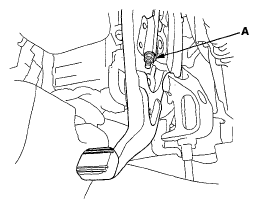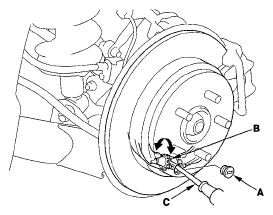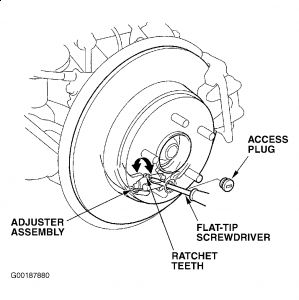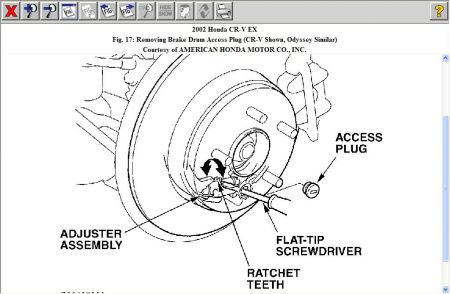MAJOR ADJUSTMENT (TO BE DONE WHEN REPLACING PARKING BRAKE SHOES)
1. Raise the rear of the vehicle, arid support it with safety stands in the proper locations
2. Release the parking brake pedal fully.
3. Back off the parking brake adjusting nut (A) in the parking brake pedal.

Fig. 9: Identifying Parking Brake Adjusting Nut
4. Remove the rear wheels.
5. Remove the access plug (A).

Fig. 10: Identifying Access Plug
6. Turn the adjuster (B) with a flat-tip screwdriver (C) until the shoes lock against the parking brake drum. Then back off the adjuster 8 clicks, and install the access plug.
7. Clean the mating surface of the brake disc/drum and the inside of the wheel, then install the rear wheels.
8. Do the minor adjustment procedure.
MINOR ADJUSTMENT
1. Raise the rear of the vehicle, and support it with safety stands in the proper locations
2. Release the parking brake pedal fully.
3. Tighten the parking brake adjusting nut (A) until the parking brakes drag slightly when the rear wheels are rotated.
After installing new parking brake shoes and/or new brake disc/drum, make sure you drive the vehicle for "break-in".
4. Back off the adjusting nut in half-turn increments.
5. Release the parking brake pedal fully, and check that the parking brakes do not drag when the rear wheels are rotated. Readjust if necessary.
6. Make sure the parking brakes are fully applied when the parking brake pedal is pressed in all the way.
Please let us know if you need anything else to get the problem fixed.
Saturday, February 20th, 2021 AT 12:39 PM
(Merged)




